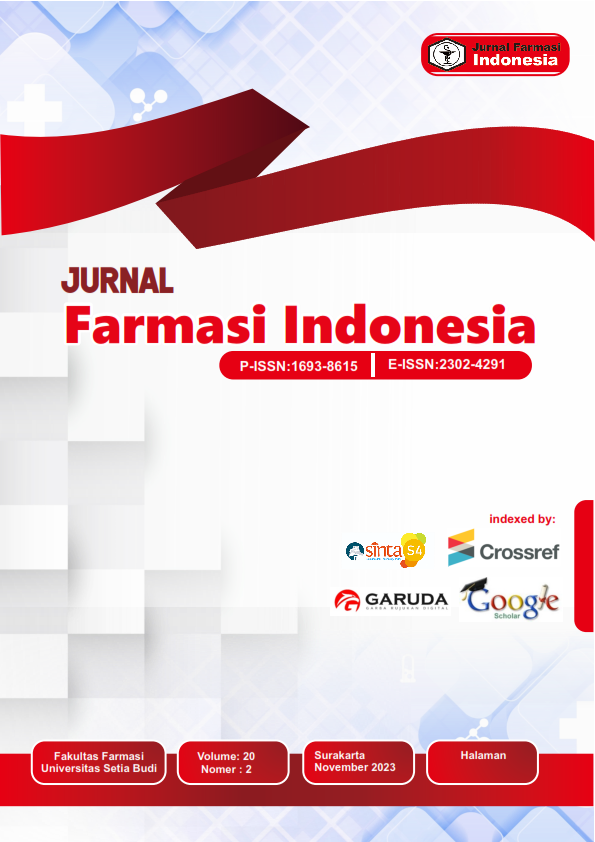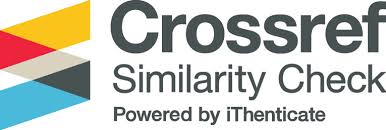Activity Test of The Purified Extract Bit Leaver (Beta vulgaris) as Antioxidant and Determination of Total Flavonoid Content
Abstract
The ethanol extract of beetroot leaves contains high levels of phenolic and flavonoid compounds, making it potentially beneficial as an antioxidant. However, the ethanol extract of beetroot leaves has a disadvantage as it is still mixed with other components that are not necessary, limiting its formulation development. In relation to this, the purpose of this research is to eliminate unwanted compounds as antioxidants and to observe the impact of purification on the antioxidant activity and total flavonoid content of the extract.
The production of purified extract involves fractionating the suspension of beetroot leaf extract using solvents with different polarities, namely n-hexane and ethyl acetate, in sequence. Antioxidant activity tests are conducted on Ethanol Extract of Beetroot Leaves (EEDUB), Purified Extract of Beetroot Leaves (ETDUB), and quercetin as a positive control. Antioxidant activity is assessed using 2,2-Diphenyl-1-Picrylhydrazyl (DPPH). The total flavonoid content of EEDUB and ETDUB is determined with a spectrophotometer using AlCl3.
The antioxidant activity of EEDUB is indicated by an IC50 value of 157.87 µg/mL, while ETDUB has an IC50 value of 129.60 µg/mL. The total flavonoid content of EEDUB is 2.82% ± 0.85 QE, and for ETDUB, it is 2.90% ± 1.16 QE. The research results show that ETDUB has a higher flavonoid content and antioxidant activity compared to EEDUB. This also indicates that the purification process of the beetroot leaf extract has not reached its maximum effectiveness.
References
[2] N. Andarwulan, R. Batari, D. A. Sandrasari, B. Bolling, and H. Wijaya, “Flavonoid content and antioxidant activity of vegetables from Indonesia,” Food Chemistry, vol. 121, no. 4, pp. 1231–1235, Aug. 2010, doi: 10.1016/j.foodchem.2010.01.033.
[3] U. Gawlik-Dziki, L. Dziki, J. Anisiewicz, E. Habza-Kowalska, M. Sikora, and D. Dziki, “Leaves of White Beetroot As a New Source of Antioxidant and Anti-Inflammatory Compounds,” Plants, vol. 9, no. 8, p. 944, Jul. 2020, doi: 10.3390/plants9080944.
[4] Z. Mzoughi et al., “Wild edible Swiss chard leaves (Beta vulgaris L. var. cicla): Nutritional, phytochemical composition and biological activities,” Food Research International, vol. 119, pp. 612–621, May 2019, doi: 10.1016/j.foodres.2018.10.039.
[5] B. H. A. Huda, H. Susanti, and N. Sugihartini, “Pengaruh purifikasi terhadap Profil Organoleptis, Rendemen, Total Fenol dan Total Flavonoid dari Ekstrak Etanol 96% daun kelor (Moringa oleifera. L).,” Jurnal Farmasi Indonesia, vol. 17, no. 2, 2020, doi : 10.31001/jfi.v17i2.983.
[6] A. D. Puspitasari and S. Pramono, “Perbandingan Metode Pembuatan Ekstrak Terpurifikasi Bee Propolis Dari Lebah Madu (Apis Mellifera) Berdasarkan Kadar Flavonoid Total Dihitung Sebagai Rutin,” Trad. Med. J., Vol. 20(2), p 76-81, 2015, doi : 10.22146/tradmedj.8076
[7] W. P. Jones and A. D. Kinghorn, “Extraction of Plant Secondary Metabolites,” in Natural Products Isolation, vol. 864, S. D. Sarker and L. Nahar, Eds., in Methods in Molecular Biology, vol. 864. , Totowa, NJ: Humana Press, 2012, pp. 341–366. doi: 10.1007/978-1-61779-624-1_13.
[8] P. E. Murwanto and D. Santosa, “Penangkapan Radikal Dpph (2,2-Difenil-1-Pikrilhidrazil),” Majalah Obat Tradisional, 2012. doi : 10.22146/tradmedj.8011
[9] A. Krisridwany, M. R. Tatra, D. P. Sukamdi, and J. Brawijaya, “Perbandingan Total Flavonoid dan Aktivitas Antioksidan Fraksi Etil Asetat Biji Kelor (Moringa oleifera L.) dan Biji Kecipir (Psophocarpus tetragonolobus L.),” Jurnal Farmasi Indonesia, vol. 19, no. 1, 2022. doi : 10.31001/jfi.v19i1.1264
[10] B. R. Prawoto and J. G. Kartika, “Pengelolaan Aspek Produksi dan Pasca Panen Sayuran Daun Secara Aeroponik dan Hidroponik : Studi Kasus Lembang, Bandung,” AGROB, vol. 4, no. 1, pp. 9–19, Jan. 2016, doi: 10.29244/agrob.v4i1.14994.
[11] S. N. Kautsari, A. Humaedi, D. R. Wijayanti, and M. Safaat, “Kadar Total Fenol dan Flavonoid Ekstrak Temu Kunci (Boesenbergia pandurata) Melalui Metode Ekstraksi Microwave,” ALCHEMY J.Pen.Kim, vol. 17, no. 1, p. 96, Mar. 2021, doi: 10.20961/alchemy.17.1.46497.96-104.
[12] H. Saadah, H. Nurhasnawati, and V. Permatasari, “Pengaruh Metode Ekstraksi Terhadap Kadar Flavonoid Ekstrak Etanol Umbi Bawang Dayak (Eleutherine Palmifolia(L.)Merr) Dengan Metode Spektrofotometri” Jurnal Borneo Journal of Pharmascientech, vol. 01, no. 01, 2017. doi : 10.51817/bjp.v1i1.46
[13] P. Molyneux, “The use of the stable free radical diphenylpicryl- hydrazyl (DPPH) for estimating antioxidant activity,” Songklanakarin Journal of Science and Technology, vol. 26, no. 2, 2004.
[14] J. Teixeira, A. Gaspar, E. M. Garrido, J. Garrido, and F. Borges, “Hydroxycinnamic Acid Antioxidants: An Electrochemical Overview,” BioMed Research International, vol. 2013, pp. 1–11, 2013, doi: 10.1155/2013/251754.
[15] D. S. Purwanto, H. Susanti, and N. Sugihartini, “Pengaruh Purifikasi Terhadap Kandungan Zat Aktif dan Aktivitas Antioksidan Ekstrak Etanol 50% Daun Kelor (Moringa oleifera L.),” jfi, vol. 18, no. 2, pp. 97–108, Nov. 2021, doi: 10.31001/jfi.v18i2.1232.
[16] S. Feghhi-Najafabadi, L. Safaeian, and B. Zolfaghari, “In vitro antioxidant effects of different extracts obtained from the leaves and seeds of Allium ampeloprasum subsp. persicum,” J Herbmed Pharmacol, vol. 8, no. 3, pp. 256–260, May 2019, doi: 10.15171/jhp.2019.37.
[17] G. Nurfiana, L. Mindi, and M. Novia, “Aktivitas Antioksidan Ekstrak dan Fraksi Daun Manggis (Garcinia mangostana) terhadap DPPH (1,1-Difenil-2-Pikrilhidrazil)”, Jurnal Farmasi Indonesia, Vol.14 no 1, doi : 10.31001/jfi.v14i1.358 .
[18] S. Gummadi and M. Kommoju, “Colorimetric Approaches To Drug Analysis And Applications“ A Review,” AJPTR, vol. 9, no. 1, pp. 14–37, Feb. 2019, doi: 10.46624/ajptr.2019.v9.i1.002.
[19] “Kajian Perbandingan Buah Black Mulberry (Morus Nigra L.) Dengan Air Terhadap Karakteristik Spreadable Processed Cheese Black Mulberry,” PFTJ, Jan. 2020, doi: 10.23969/pftj.v6i3.2175.
[20] D. A. A. Makuasa and P. Ningsih, “The Analysis of Total Flavonoid Levels In Young Leaves and Old Soursop Leaves (Annona muricata L.) Using UV-Vis Spectrofotometry Methods,” J. Appl. Sci. Eng. Technol. Educ., vol. 2, no. 1, pp. 11–17, May 2020, doi: 10.35877/454RI.asci2133.
[21] T. G. Arikalang, S. Sudewi, and J. A. Rorong, “Daun Gedi Hijau (Abelmoschus Manihot L.) yang Diukur,” Jurnal Farmasi Indonesia, vol. 7, no. 3, 2018, DOI: 10.30595/pji.v9i3.762













